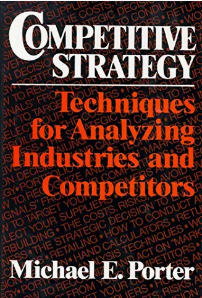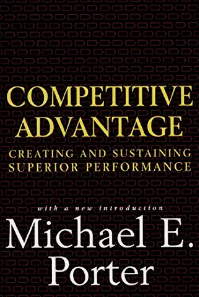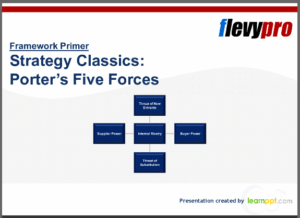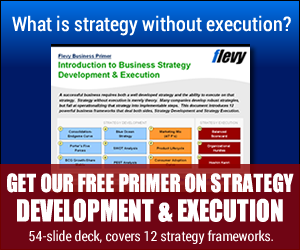Is there a way to boil down strategic choices to three generic strategies? Strategy guru Michael Porter has done just that.
This post explores the generic strategies, the pitfalls in choosing one, and their importance to project managers.
Overview of Porter’s Three Generic Strategies
 It may seem funny to illustrate Three Generic Strategies with a quad chart! Let me try to explain.
It may seem funny to illustrate Three Generic Strategies with a quad chart! Let me try to explain.
The key is to understand the vertical and horizontal axes of the graph.
- Scope – The strategy can be either Broad or Narrow in scope. Choices will need to be made based upon the Five Forces Framework. How is the industry structured? Where does the organization fit now, and potentially into the future? Where does it have the best chance of success?
- Source of Competitive Advantage – The strategy will be to build competitive advantage through either Cost or Differentiation. What is the organization’s Value Chain? Where does it have an advantage – potentially an Absolute or Comparative Advantage? What competitive powers does the organization have that might translate to competitive advantage?
So how do Scope and Source of Competitive Advantage translate into Three Generic Strategies?
Two of the strategies – Cost Leadership and Differentiation – are Broad in Scope, and thus occupy to top two boxes in the quad chart.
The third generic strategy, Focus, encompasses both of the bottom two boxes in the quad chart. A Focus strategy can be based on either a Focus on Cost or Focus on Differentiation.
You will find a simple video explanation of Porter’s Generic Strategies on YouTube.
You can get right to the core of Michael Porter’s thinking in his two seminal books, “Competitive Strategy” and “Competitive Advantage“, as well as “Understanding Michael Porter” by Joan Magretta.
Let’s explore in more detail each of the Three Generic Strategies.
The Cost Leadership Strategy
 The Cost Leadership strategy is at the intersection of where Scope is Broad and Cost is the Source of Compeltitive Advantage.
The Cost Leadership strategy is at the intersection of where Scope is Broad and Cost is the Source of Compeltitive Advantage.
This strategy is usually the domain of larger organizations. It also is something that is able to happen once the industry reaches a high level of maturity, as early stages of industry maturity are only minimally driven by Cost.
Cost relates to the following types of elements:
- Raw materials acquisition
- Manufacturing
- Distribution
- Sales process
- Customer service
- Other business processes
A driver of lower cost opportunities is volume. An industry participant can drive its way to higher volume and lower cost ahead of the competition. However, it usually takes substantial investment and staying power to get to the highly profitable mature stage.
What are some pros, cons, and issues of a Cost Leadership strategy?
- Can be risky for a competitors that cannot withstand the potential for low returns and limited ash flow in driving up the growth curve.
- Organization’s inherent strength in cost control
- Skill delivering projects aimed at cost reduction and control
- Any orientation toward differentiation needs to be secondary or avoided
- Not innovative in a product sense, except as relates to cost
The Differentiation Strategy
 The Differentiation strategy is situated in the diagram at the intersection where Scope is Broad Scope and Differentiation as the Source of Competitive Advantage.
The Differentiation strategy is situated in the diagram at the intersection where Scope is Broad Scope and Differentiation as the Source of Competitive Advantage.
A strategy of Differentiation, like a strategy of Cost Leadership, is usually the domain of larger competitors. It requires substantial investment in order to achieve differentiation, especially when it is done broadly across the whole range of industry segments.
Differentiation can occur in a number of ways, such as:
- Special branding
- Higher quality inputs or materials
- More personalized customer service
- More flexible delivery options
- Proprietary value-added production process
There are many ways to differentiate. The organization’s value chain provides indications as to where it might differentiate most effectively.
Differentiation is targeted to higher pricing – to pay for the substantial development costs and to generate higher profits.
The following are some pros, cons, and necessary conditions for following a Differentiation strategy:
- The organization needs to be strong financially to handle substantial investment.
- It helps to have strong branding, or a tendency toward it.
- The personality or culture of the organization needs to support creativity and innovation.
Differentiation is a strategy that requires commitment, with cost a subordinate consideration.
The Focus Strategy
 A Focus strategy is by definition Narrow in Scope. The target is a segment of the market.
A Focus strategy is by definition Narrow in Scope. The target is a segment of the market.
However, a Focus strategy can be achieved through both Cost and Differentiation. Thus, it encompasses both quadrants at the bottom of the quad chart.
A strategy of Focus can be the domain of large or small competitors. Because it does not depend on volume or breadth, smaller competitors have a chance to be successful.
Some keys to success in a Cost Focus strategy include:
- Develop an offering that, in one particular segment, offers a lower cost offering than the Cost Leader
- The Cost Leader should be unable, based on its covering of all segments, to complete on cost specifically in this segment
- Identify specific opportunities to uniquely cut costs in a way that satisfies a particular segment
- Consider creating a new segment – using a strategy of innovation of selling to customers that are currently not buyers
The key to success in the Differentiation Focus strategy is to pick a segment that the organization can potentially dominate. That requires a uniquely strong understanding of the customer, and an equally unique way of doing business that serves that segment of customers.
Choosing One of the Three Generic Strategies
Choosing one of the generic strategies is not easy. Here are some tricks and traps involved.
—————————————-
The following are my three favorite Michael Porter books (paid links, also pictured below):
- “Competitive Strategy: Techniques for Analyzing Industries and Competitors“, by Michael Porter
- “Understanding Michael Porter: The Essential Guide to Competition and Strategy“, by Joan Magretta
- “Competitive Advantage: Creating and Sustaining Superior Performance“, by Michael E. Porter
And of course there are more excellent Michael Porter books.
 |
 |
 |
—————————————-
- Choosing different strategies for different parts of the organization – For a small company, there must be a clear focus; there is only one part to the organization. Larger organizations can consist of multiple well-defined businesses where the strategies may differ. The key will be to segment those parts of the organization sufficiently to allow them to flourish in their own culture, structure, and processes.
- Finding a happy balance across the quadrants – There may be a way to find balance across segments – or maybe not. It will depend on how different the parts of the business are. It is important to consider that a strategy of Cost Leadership is most likely incompatible with a strategy of Differentiation. In addition, Broad strategies will be incompatible with Narrow strategies of Focus.
- Risk of being stuck in the middle – When a company does not choose well, and tries to be all things to all customers, it is likely to become neither cost effective nor differentiated nor focused. It would find itself somewhere in the middle of the chart and would be vulnerable to competitors that are clear Cost Leaders, Differentiators, or narrowly Focused.
Strategists and executives need to be wary of the risks, and be definitive in making decisions with clear direction.
Project Management and Porter’s Three Generic Strategies
Michael Porter differentiated two types of projects in his presentation on Strategy and Project Management to the PMI.
- Cost driven projects – These projects are aimed at being more efficient. They are driven by best practices. While all organizations need to adopt best practices and build discipline within the organization, this is unlikely to get a company ahead unless they are the Cost Leader or have a Cost Focus.
- Strategically driven projects – These projects are driven by a strategic need to innovate – or differentiate. They are like projects driven by a Blue Ocean strategy; a Blue Ocean strategy positions the organization in segments where there is little or no competition. Note that unlike other strategic frameworks, execution (i.e. project management) is baked into the Blue Ocean approach.
—————————————-
I recommend these PM templates (paid link):
—————————————-
Both types of projects are important. However, it is most important to have a dominance of cost driven projects when the strategy is Cost driven – either Cost Leadership or Cost Focus. Likewise, it is critical that most projects in differentiated organizations – strategies of Differentiation or Differentiation Focus – are strategically driven projects.
From an execution perspective, the organization needs to have alignment throughout, as can be determined by the McKinsey 7S Model or the Nadler Tushman Congruence Model. Gap analysis can help identify areas that need attention to gain alignment.
Most importantly, all project professionals – project managers, portfolio managers, program managers, and PMO leaders – need to align behind the generic strategy choices that their organization picks.
Conclusion and Further Resources
What do you think – are there three generic strategies…or is it four? Let us know what you think, and the impact that it has.
—————————————-
Do you need some professional slides for a presentation on this or related strategic topics? I suggest the flevy Marketplace for Business Best Practices, and consider these particular Michael Porter documents:
| Strategy Classics: Porter’s Five Forces (28-slide ppt) – $25 | Strategy Classics: Porter’s Value Chain (23-slide ppt) – $25 |
—————————————-
For a deep dive into Michael Porter’s thinking, see his two seminal books, “Competitive Strategy” and “Competitive Advantage“. I also recommend a shorter and well written book, “Understanding Michael Porter“, by Joan Magretta.
And of course there are more excellent Michael Porter books.
 |
 |
 |
Follow the link for a slightly longer (15 min) video which does a good job of covering the basics of Porter’s Generic Strategies.
—————————————-
I recommend these strategy resources (paid link):
—————————————-



